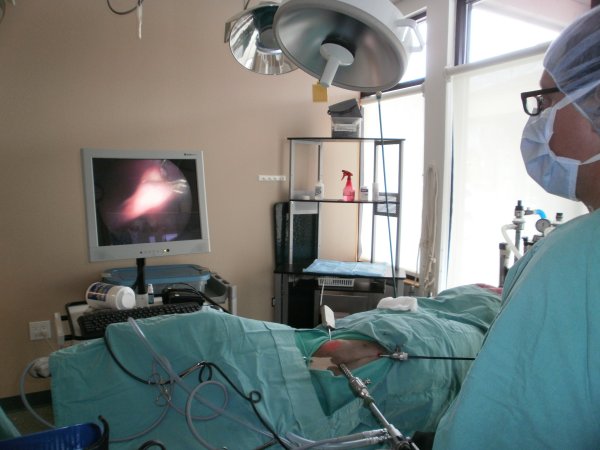|
Minimally Invasive / Laparoscopic Spay (L-OVE)
The
benefits of L-OVE are as follows:
What
to expect from a L-OVE: A 10mm long (dime sized) incision (or as large as the ovary) just caudal to the umbilicus. Occasionally we will need a second incision 5mm long. There may be a couple of very small red spots (from a needle size instrument) on either side of the abdomen. The laparoscopic technique requires a slightly wider belly clip/shave. Quicker return to full function (2-4 days) than a conventional spay (7-10 days), and 60% less pain and stress after surgery. Ovariectomy
vs. Ovariohysterectomy:
Why
we used to only spay dogs with OHE: It was traditionally thought that leaving the uterus adds risk of a future uterine infection or pyometra. Occasionally, some spayed females develop "stump-pyometra" which is infection of the small amount of uterus that is left behind in an OHE. This infection develops only under the influence of a hormone called progesterone, which is only made by the ovaries. Previous research supported that there may be a link between infections and the amount of uterus left behind. Some rational followed that this must mean that some progesterone is made by the uterus. Why
we now support spaying dogs with OVE: According to European research, where almost all routine spays have always been OVE, the risk for pyometra is actually lower for OVE than OHE. This is likely because the surgeon gets better exposure and visualization of the ovaries in an OVE rather than the OHE where the surgeon makes a compromising middle incision that will also be used to remove the uterus. The evidence now shows that there is no progesterone made by the uterus and so OHE carries no advantage over the OVE. OVE however has many advantages over the OHE, especially when performed through minimally invasive surgery. Why
we now try to provide minimally invasive L-OVE's to all our RCHS spays: If you have questions about your dog, one of the above techniques of spaying, or any concerns, please call to speak with a member of our staff. As with any surgery, if you suspect your animal is painful or experiencing a complication, please call a doctor at Pet Kare Clinic immediately so we can help your pet! Downloadable Media From Laparoscopic Spays:
|
||||

 Pet
Kare Clinic is pleased to be the first to offer laparoscopic spays to
the western slope of Colorado. This minimally invasive spay technique
raises the standard of care for elective abdominal surgery. Here are
the facts:
Pet
Kare Clinic is pleased to be the first to offer laparoscopic spays to
the western slope of Colorado. This minimally invasive spay technique
raises the standard of care for elective abdominal surgery. Here are
the facts: